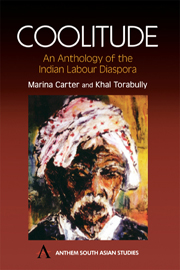Book contents
- Frontmatter
- Contents
- Introduction
- The Coolie Odyssey: A Voyage In Time And Space
- Thrice Victimized: Casting The Coolie
- Surviving Indenture
- Reclaiming The ‘Other’: Diaspora Indians And The Coolie Heritage
- Some Theoretical Premises Of Coolitude
- Conclusion: Revoicing the Coolie
- Poetic And Critical Texts Of Coolitude
- Notes
- Bibliography
Thrice Victimized: Casting The Coolie
Published online by Cambridge University Press: 05 March 2012
- Frontmatter
- Contents
- Introduction
- The Coolie Odyssey: A Voyage In Time And Space
- Thrice Victimized: Casting The Coolie
- Surviving Indenture
- Reclaiming The ‘Other’: Diaspora Indians And The Coolie Heritage
- Some Theoretical Premises Of Coolitude
- Conclusion: Revoicing the Coolie
- Poetic And Critical Texts Of Coolitude
- Notes
- Bibliography
Summary
The coolie has always been negatively portrayed. Contemporaries dismissed labour migrants as the ‘sweepings of Calcutta's slums’; the contracts they signed victimized them further, by identifying them as a societal ‘other’ – a prey to prison, pariahs amongst free men. As coolies settled in the countries which had imported them as plantation labourers, they began to feature in literary accounts, but were always redolent of exoticism, images of alienness, barbarism and fatalism casting them permanently in their lowly agricultural role. The hindsight of historians has served the coolies little better: they have been assigned the status of ‘neo-slave’, stripped of caste, culture, even of family in some accounts. This chapter deconstructs the changing stereotype of the coolie.
Contemporary Views of the Coolie
The overseas Indian labourer entered the perception of the colonial planter and administrator in the early decades of the nineteenth century as it became clear, from increasing agitation in Britain, that slavery as a system was doomed. Intellectuals of the period, however, were convinced that European men were constitutionally incapable of dealing with labour in tropical climates. Earl Grey's comments typify the thinking of the period on this matter:
‘In all European countries, the necessity of supplying their daily wants is, to the labouring classes, a sufficient motive to exertion. But the case is very different in tropical climates, where the population is very scanty in proportion to the extent of territory; where the soil … readily yields a subsistence in return for very little labour; and where clothing, fuel, and lodging, such as are there required, are obtained very easily. […]
- Type
- Chapter
- Information
- CoolitudeAn Anthology of the Indian Labour Diaspora, pp. 45 - 87Publisher: Anthem PressPrint publication year: 2002



